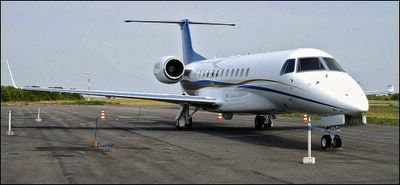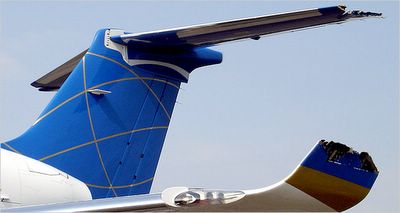Después de varios días del aterrizaje forzoso del Legacy, por fin, la Fuerza aérea brasileña se ha animado a publicar la foto del aparatito de marras.

Lo miro y no lo creo. No le veo un solo raspón. ¿Cómo hicieron?
Quizás debí comenzar este post: Como chocar con un Boeing 737 sin dejar huellas.
A ver si Joe Sharkey nos esclarece esta duda.
Chocar chocar... la palabra me parece demasiado grande.
Relacionado:
Noticia ampliada en yahoo y más fotos
Noticia en Folha, inundado de elecciones, pero ahí esta el avión pintando su nota.
Una cosa más, en los comments del blog de Joe se ha iniciado una discusión sobre la retención de los pilotos. Joe Sharkey no comprende porque los han retenido. Si hubiera sucedido en gringolandia, temen los comentaristas, los halcones ya estarían torturando a los pilotos del jet.
Actualización 3 de octubre:

Un fotógrafo con más tino nos despeja la duda. La columna de Joe Sharkey, en el NYT.
SÃO JOSE DOS CAMPOS, Brazil, Oct. 1 — It had been an uneventful, comfortable flight.
With the window shade drawn, I was relaxing in my leather seat aboard a $25 million corporate jet that was flying 37,000 feet above the vast Amazon rainforest. The 7 of us on board the 13-passenger jet were keeping to ourselves.
Without warning, I felt a terrific jolt and heard a loud bang, followed by an eerie silence, save for the hum of the engines.
And then the three words I will never forget. “We’ve been hit,” said Henry Yandle, a fellow passenger standing in the aisle near the cockpit of the Embraer Legacy 600 jet.
“Hit? By what?” I wondered. I lifted the shade. The sky was clear; the sun low in the sky. The rainforest went on forever. But there, at the end of the wing, was a jagged ridge, perhaps a foot high, where the five-foot-tall winglet was supposed to be.
And so began the most harrowing 30 minutes of my life. I would be told time and again in the next few days that nobody ever survives a midair collision. I was lucky to be alive — and only later would I learn that the 155 people aboard the Boeing 737 on a domestic flight that seems to have clipped us were not.
Investigators are still trying to sort out what happened, and how — our smaller jet managed to stay aloft while a 737 that is longer, wider and more than three times as heavy, fell from the sky nose first.
But at 3:59 last Friday afternoon, all I could see, all I knew, was that part of the wing was gone. And it was clear that the situation was worsening in a hurry. The leading edge of the wing was losing rivets, and starting to peel back.
Amazingly, no one panicked. The pilots calmly starting scanning their controls and maps for signs of a nearby airport, or, out their window, a place to come down.
But as the minutes passed, the plane kept losing speed. By now we all knew how bad this was. I wondered how badly ditching — an optimistic term for crashing — was going to hurt.
I thought of my family. There was no point reaching for my cellphone to try a call — there was no signal. And as our hopes sank with the sun, some of us jotted notes to spouses and loved ones and placed them in our wallets, hoping the notes would later be found.
I was focused on a different set of notes when the flight began. I’ve contributed the “On the Road”column for The New York Times business-travel section every week for the last seven years. But I was on the Embraer 600 for a freelance assignment for Business Jet Traveler magazine.
My fellow passengers included executives from Embraer and a charter company called ExcelAire, the new owner of the jet. David Rimmer, the senior vice president of Excel Aire, had invited me to ride home on the jet his company had just taken possession of at Embraer’s headquarters here.
And it had been a nice ride. Minutes before we were hit, I had wandered up to the cockpit to chat with the pilots, who said the plane was flying beautifully. I saw the readout that showed our altitude: 37,000 feet.
I returned to my seat. Minutes later came the strike (it sheared off part of the plane’s tail, too, we later learned).
Immediately afterward, there wasn’t much conversation.
Mr. Rimmer, a large man, was hunched in the aisle in front of me staring out the window at the newly damaged wing.
“How bad is it?” I asked.
He fixed me with a steady look and said, "I don’t know."
I saw the body language of the two pilots. They were like infantrymen working together in a jam, just as they had been trained to do.
For the next 25 minutes, the pilots, Joe Lepore and Jan Paladino, were scanning their instruments, looking for an airport. Nothing turned up.
They sent out a Mayday signal, which was acknowledged by a cargo plane somewhere in the region. There had been no contact with any other plane, and certainly not with a 737 in the same airspace.
Mr. Lepore then spotted a runway through the darkening canopy of trees.
“I can see an airport,” he said.
They tried to contact the control tower at what turned out to be a military base hidden deep in the Amazon. They steered the plane through a big wide sweep to avoid putting too much stress on the wing.
As they approached the runway, they had the first contact with air traffic control.
“We didn’t know how much runway we had or what was on it,” Mr. Paladino would say later that night at the base in the jungle at Cachimbo.
We came down hard and fast. I watched the pilots wrestle the aircraft because so many of their automatic controls were blown. They brought us to a halt with plenty of runway left. We staggered to the exit.
“Nice flying,” I told the pilots as I passed them. Actually, I inserted an unprintable word between “nice” and “flying.”
“Any time,” Mr. Paladino, said with an anxious smile.
Later that night they gave us cold beer and food at the military base. We speculated endlessly about what had caused the impact. A wayward weather balloon? A hot-dogging military fighter jet whose pilot had bailed? An airliner somewhere nearby that had blown up, and rained debris on us?
Later that night they gave us cold beer and food at the military base. We speculated endlessly about what had caused the impact. A wayward weather balloon? A hot-dogging military fighter jet whose pilot had bailed? An airliner somewhere nearby that had blown up, and rained debris on us?
No hay comentarios.:
Publicar un comentario